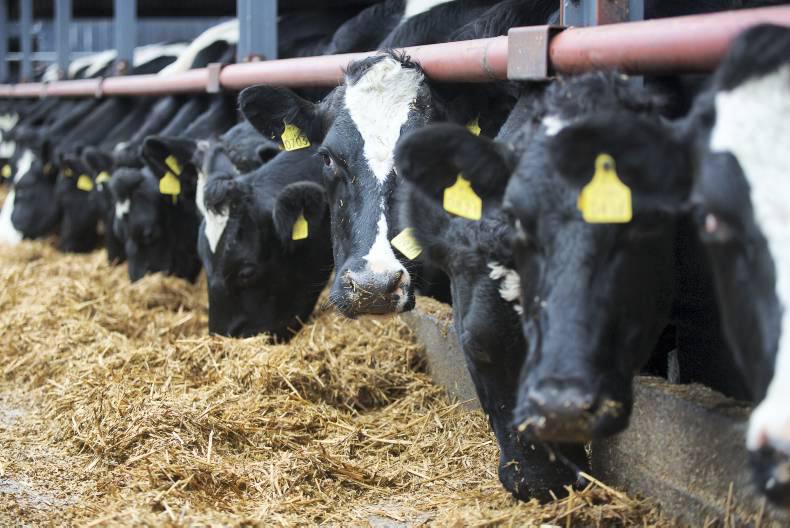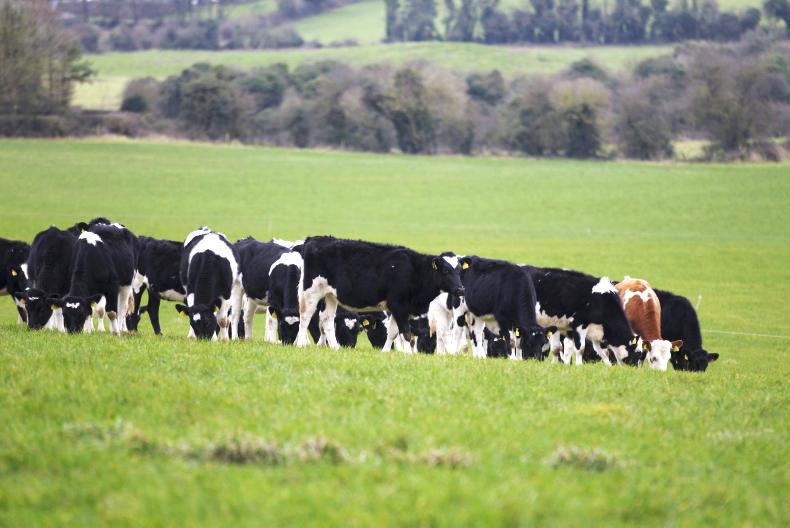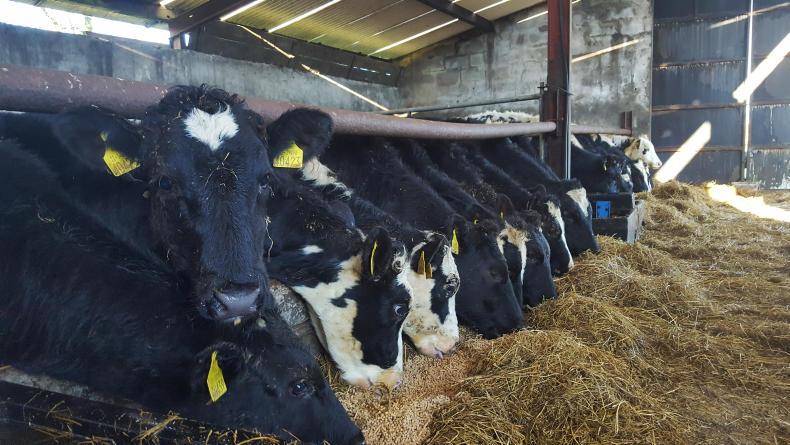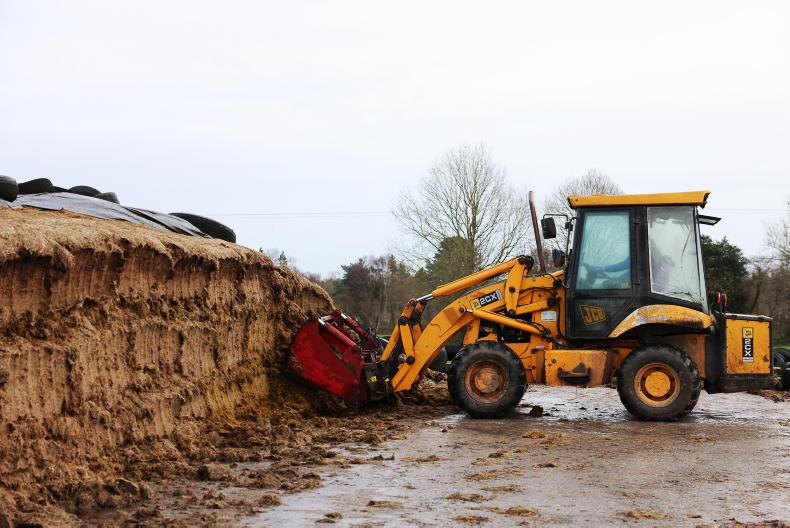What meals should farmers be feeding this spring? To answer the question, we need to break farmers down into three groups. The first group are those who are committed to grass and are on dry farms that will get cows out almost every day this spring, irrespective of the weather, through using the tools available such as on/off grazing and having good grazing infrastructure.
The second group are also committed to grass but because of high stocking rates or wet land or poor infrastructure, they can only get out to grass part-time.
The third group are those on heavier land who are not certain about getting cows out until mid-March or April. Let’s analyse the most cost-effective feeding options for each of these farmers this spring.
Farmer A – High grass
Spring grass is the best feed available. It is high in energy (1.06 UFL/kg DM) and protein (22%) and it costs only a fraction of any other feed at about 7c/kg DM. While there is more grass around this spring than in other years, most farmers will still need to supplement grass with some other feeds to push out the first rotation to 1 April.
If average farm cover is over 800kg/ha, and if stocking rate and calving pattern are reasonable, then the most feed required should be in the region of 2kg to 3kg per cow per day. On some lowly stocked farms or farms with a later calving profile, little or no supplement will be required and this is perfectly fine from a nutritional point of view, even though the protein level in the overall diet will be high. In short, grass is enough if you have enough grass.
Because grass is high in protein, a high protein supplement is not necessary where there is plenty of grass in the diet. The overall protein in the diet in early lactation should be around 17%. Grass at 22% protein is greater than this so a low protein supplement will suffice and the overall protein content in the diet won’t drop below 17%.
While the energy content in spring grass is less plentiful than protein, it is still not limiting production when sufficient grass is fed. If we take it that a cow producing 1.7kg of milk solids per day from week four on requires 13.75 UFL for production and maintenance and if grass has 1.06 UFL/kg DM, then feeding 12kg of grass would provide 12.72 UFL, leaving a shortfall of just over 1 UFL per day. Let’s say 2kg DM of supplement needs to fed, bringing the overall diet in early lactation to 14kg DM per day. An ideal supplement in this instance would be soya hulls at 0.88 UFL/kg as fed, 12% protein and 40% crude fibre. Soya hulls are available blown into a feed bin for €170/t or 19c/kg DM. The total energy in this diet is 14.5 UFL (1.03 UFL/kg DM), 20.5% protein and the feed cost per cow in this scenario is €1.22/cow/day.
Farmer B – Some grass
The Farmer A option is the ideal scenario, but not everyone can manage to get cows out full-time in spring due to high stocking rates, heavy land, or a very high demand, eg autumn-calving herds. But even where some grass is included in the diet, such as grazing during the day, it can have a big effect on reducing the feed costs.
Silage is low in crude protein at 11.5% and average quality silage (68% DMD) has a UFL of 0.76/kg, so it is an inferior feed to grass. It also costs over twice as much at about 15c/kg DM. As a comparison, feeding 12kg of silage will only provide the same energy or UFL as feeding 9kg of spring grass.
If 6kg of grass is fed per day along with 6kg of silage, the total energy in the diet will be 10.92 UFL. So this diet is short in energy. Therefore, the energy component in the supplement is important – much more so than when cows are out fulltime.
Feeding a three-way mix of maize meal, soya hulls and maize distillers gives a UFL of 0.99/kg as fed and a crude protein of 15%. This mix is available for about €235/t. Feeding 3kg DM of this three-way mix will result in the overall diet having a crude protein of 16.4% and will supply 13.89 UFL (0.93 UFL/kg DM). The feed cost in this scenario is €2.10 per cow per day.
Farmer C – Low grass
The reality is that not every farm can get out to grass full-time from calving. Early spring grazing is much more of a challenge on heavier soils and farms with inadequate infrastructure. In these situations, farmers must budget to have milking cows fully housed for periods of time, depending on the weather and ground conditions.
The best practice in such scenarios is to graze as much as possible when conditions are suitable by reducing the level of supplement being fed when cows are at grass. When housed, there is no option but to increase the level of meals to try and balance the diet for energy and protein – this is the challenge of farming on wet land.
Feeding extra meals when indoors will only partly make up the difference in energy levels between grass and silage. Feeding 5kg DM of meal with a UFL of 0.95 along with 10kg of 68% DMD silage will give a total energy intake of 12.35 UFL, sufficient to produce about 1.45kg milk solids per cow per day. Generally, silage is offered ad-lib when indoors. For every extra 1kg DM of silage eaten, the extra energy consumed is sufficient to produce an extra 0.13kg of milk solids per cow per day, but remember that cows have a low intake for the first few weeks after calving.
Indoor diets tend to be deficient in protein. If 10kg of grass silage is being fed along with 5kg of an 18% protein meal, the protein level in the overall diet is 14%, short of the 17% target. Increasing to a 20% protein meal increases the protein level in the overall diet to 14.5%. This meal costs about €300/t. The daily costs per cow of feeding 10kg of silage and 5kg DM of 0.95 UFL meal with a protein content of 20% is €3.16.
Comment
There is a clear difference in energy intakes between the different feed scenarios. Some people will argue that extra meal must be fed in the indoor scenario to prevent excessive body condition score loss post-calving. While it is possible to do, the economics of feeding 5kg of meal, let alone any more, just doesn’t stack up. Remember, no amount of feeding will stop body condition score loss post-calving – it is a natural occurrence.
There is a €2/cow/day difference in feed costs between the high-grass and the low-grass farmer. For me, this really shows where the potential is for reducing costs this spring. This is before all the other benefits of grazing are considered – extra milk solids, lower housing costs etc.
Some people argue that grass dry matters are too variable and extra meal should be fed to counteract this. Let’s be clear – if grass is low in dry matter, the cows will eat more of it to get their fill; if grass is high in dry matter, they will get their fill with fewer bites. It is not until grass drops below 12% DM that intakes may suffer and this rarely happens.
Another reason some people use for feeding meal is to counteract the excess protein in grass. Research from grass based systems around the world says there is no link between excess dietary protein and subsequent fertility performance.
To get the most out of grass, significant cost savings can be made by purchasing lower-spec supplements. Where grass is plentiful, straights such as soya hulls are ideal and can be put through in-parlour feeders without causing problems. However, if feeding straights, then minerals need to be supplied in some other form.










SHARING OPTIONS